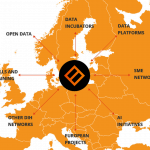Digital transformation: how to avoid missing out on the new phase of work that has begun
Aurélie Dudézert, Institut Mines-Télécom Business School and Florence Laval, IAE de Poitiers
[divider style=”normal” top=”20″ bottom=”20″]
[dropcap]A[/dropcap]fter a lockdown that has helped reveal how far along companies are in their digital transformation, the easing of lockdown measures has ushered in a new phase marked by a desire to return to “normal” activities, which is impossible due to changing health restrictions.
Some organizations have therefore tried to use the health context as a pretext for regaining control over informal exchanges and adjustments that are impossible to control in a remote work environment (employees clocking in on site vs. remotely; identifying who is working with whom, at what time, etc.).
The organizational agility required for the goal of digital transformation and implemented in teams during the lockdown has been undermined by attempts to standardize work and return to uniform processes for the entire organization.
Mask-wearing has also become a point of tension. Besides being uncomfortable, masks conceal faces after what was often a period of remote work – in which it was difficult to perceive others’ emotions – and therefore complicate relationships. We must learn to read emotions differently and communicate with others differently.
These challenges are compounded by uncertainty over changing health restrictions. Highly adaptive ways of working must be put in place. Periods of site closures are followed by periods of hybrid work with employees taking turns working on site to comply with health restrictions.
Designing the transformation
After learning how to work together remotely, employees and managers must once again learn how to work together constantly.
To respond to this situation, three strategies, which we explain in the collective work L’impact de la crise sur le management (The Impact of the Crisis on Management, Éditions EMS) seem to be useful to help get through this second wave of the crisis and continue the digital transformation of working methods.
The first is to work with teams on emerging stress and tensions by seeing them not as symptoms of individuals’ inability/incompetence to cope with the situation, but as drivers for developing appropriate ways to coordinate work.
For instance, if mask-wearing is a source of tension, bringing teams together to discuss what is causing the tension could provide an opportunity to create a new working arrangement that is more effective and better-suited to the new digital environment. This means that the manager must acknowledge employees’ experiences and perceptions and take them seriously so they can be revealed as expectations, such as creativity, or as the rejection of the organization and its goals.
The second strategy is to develop reflexive management, which takes an objective look at the work methods put in place in the current adaptation phase. It is quite clear today that work practices are moving towards a hybridization between working from the office/remotely and synchronous/asynchronous.
Rather than seeing the successive changes in health regulations as constraints, which make it difficult to do business and seamlessly continue their digital transformation, organizations would benefit from taking advantage of these periodic adjustments to gain insight into the pros and cons of this hybrid system.
This objective look could provide an opportunity to characterize which activities specific to each team are indisputably more productive in person than remotely, or to determine how to manage teams working both from home and on-site.
The third strategy is to “encourage digital intelligence”, meaning working with the team to determine the requirements and uses of digital technology, depending on working methods. For example, it may not be necessary to upgrade employees’ skills to increase their proficiency in an entire collaborative work if the goal is simply to enable them to work together via web conference.
Overstretching employees at such an uncertain and strange time is an additional risk that could undermine the digital transformation process. Going back to the basic uses of digital technology in order to carry out tasks seems to be much more useful and effective.
Aurélie Dudézert, Full Professor, IMT BS, Institut Mines-Télécom Business School and Florence Laval, Lecturer at IAE de Poitiers
This article has been republished from The Conversation under a Creative Commons. Read the original article (in French).





Trackbacks & Pingbacks
[…] Read the article […]
Leave a Reply
Want to join the discussion?Feel free to contribute!